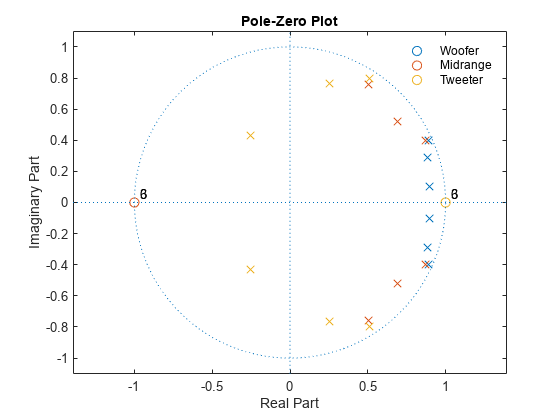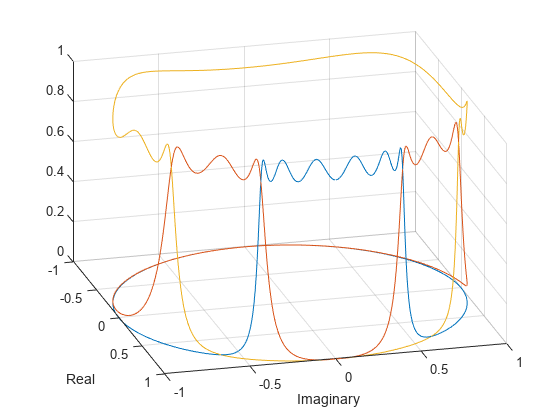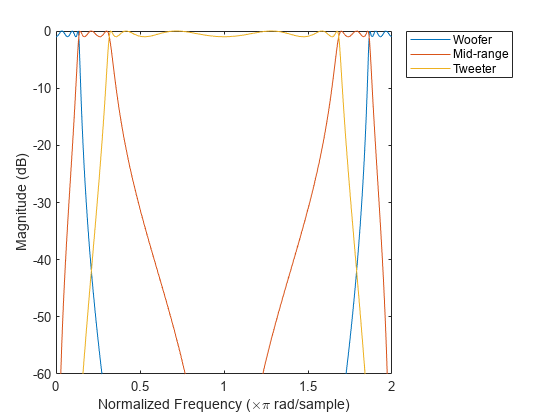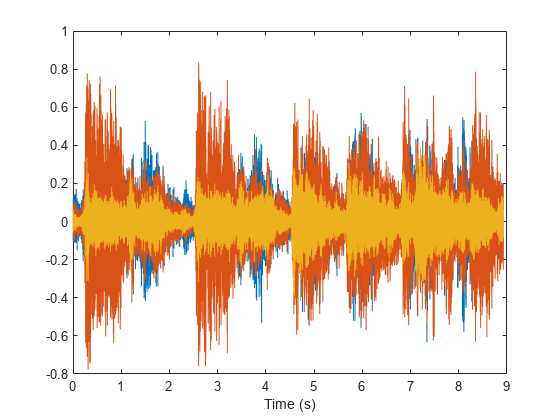スピーカーの交差フィルター
この例では、デジタル 3 ウェイ ラウドスピーカーの単純なモデルをどのように考案するかを説明します。システムは、オーディオ入力をウーファー、ミッドレンジ ドライバーおよびツィーターにそれぞれ対応する、低周波数帯域、中周波数帯域および高周波数帯域に分割します。帯域を区切る正規化交差周波数の標準値は、 ラジアン/サンプルおよび ラジアン/サンプルです。
ローパス、バンドパスおよびハイパス フィルターを作成し、低周波数、中周波数および高周波数の帯域を生成します。周波数を指定します。
lo = 0.136; hi = 0.317;
各フィルターには 6 次のチェビシェフ I 型設計を使用します。実際のスピーカーの値より大きい 1 dB を通過帯域リップルに指定します。関数 cheby1 は、バンドパス設計の次数を 2 倍にします。バンドパス フィルターの次数を半分にして、すべてのフィルターの次数が同じになるようにします。各フィルターの零点、極およびゲインを返します。
ord = 6;
rip = 1;
[zw,pw,kw] = cheby1(ord,rip,lo);
[zm,pm,km] = cheby1(ord/2,rip,[lo hi]);
[zt,pt,kt] = cheby1(ord,rip,hi,'high');フィルターの零点と極を可視化します。
zplane([zw zm zt],[pw pm pt]) lg = legend('Woofer','Midrange','Tweeter'); lg.Box = 'off';

ウーファー: の零点は、高周波数を抑制します。極は、 と低位の交差周波数の間の振幅応答を強化します。
ミッドレンジ: と の零点は、高周波数と低周波数を抑制します。極は、低位と高位の交差周波数の間の振幅応答を強化します。
ツィーター: の零点は、低周波数を抑制します。極は、高位の交差周波数と の間の振幅応答を強化します。
単位円上に振幅応答をプロットし、異なる極と零点の効果を確認します。線形ユニットを使用します。フィルターを 2 次セクションで表現します。
sw = zp2sos(zw,pw,kw); sm = zp2sos(zm,pm,km); st = zp2sos(zt,pt,kt); nf = 1024; [hw,fw] = freqz(sw,nf,'whole'); hm = freqz(sm,nf,'whole'); ht = freqz(st,nf,'whole'); plot3(cos(fw),sin(fw),[abs(hw) abs(hm) abs(ht)]) xlabel('Real') ylabel('Imaginary') view(75,30) grid

振幅応答を dB 単位でプロットします。
plot(fw/pi,mag2db(abs([hw hm ht]))) legend('Woofer','Mid-range','Tweeter') xlabel('Normalized Frequency (\times\pi rad/sample)') ylabel('Magnitude (dB)') ylim([-60 0])

8192 Hz でサンプリングされたヘンデルの「ハレルヤ コーラス」の断章を含むオーディオ ファイルを読み込みます。フィルター処理によって、信号を 3 つの周波数帯域に分割します。帯域をプロットします。
load handel % To hear, type soundsc(y,Fs) yw = sosfilt(sw,y); % To hear, type soundsc(yw,Fs) ym = sosfilt(sm,y); % To hear, type soundsc(ym,Fs) yt = sosfilt(st,y); % To hear, type soundsc(yt,Fs) plot((0:length(y)-1)/Fs,[yw ym yt]) xlabel('Time (s)')

% To hear all the frequency ranges, type soundsc(yw+ym+yt,Fs)参考文献
Orfanidis, Sophocles J. Introduction to Signal Processing. Englewood Cliffs, NJ: Prentice Hall, 1996.